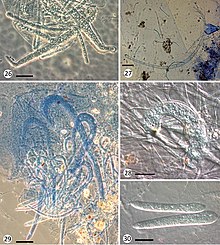| Paramoebidiidae | |
|---|---|

| |
| Scientific classification | |
| Domain: | Eukaryota |
| (unranked): | Opisthokonta |
| (unranked): | Holozoa |
| Class: | Ichthyosporea |
| Order: | Ichthyophonida |
| Family: | Paramoebidiidae Reynolds et al. 2017 |
| Genus | |
Paramoebidiidae is a family of single-celled eukaryotes, previously thought to be zygomycete fungi belonging to the class Trichomycetes, but molecular phylogenetic analyses place the family with the opisthokont group Mesomycetozoea (= Ichthyosporea). The family was originally called Amoebidiaceae, and considered the sole family of the fungal order Amoebidiales that included two genera, Amoebidium and Paramoebidium. However, Paramoebidium is now the sole genus of the family Paramoebidiidae and Amoebidiidae is likewise monogeneric as it was recently emended to include only Amoebidium. Species of Paramoebidium are obligate symbionts of immature freshwater-dwelling arthropod hosts such as mayfly and stonefly nymphs and black fly larvae. Paramoebidium species attach to the digestive tract lining of their host via a secreted holdfast.
References
- ^ Reynolds, N.K., M.E. Smith, E.D. Tretter, J. Gause, D. Heeney, M.J. Cafaro, J.F. Smith, S.J. Novak, W.A. Bourland, M.M. White. 2017. Resolving relationships at the animal-fungal divergence: A molecular phylogenetic study of the protist trichomycetes (Ichthyosporea, Eccrinida). Molecular Phylogenetics and Evolution in press, available online 20Feb.2017. https://dx.doi.org/10.1016/j.ympev.2017.02.007
- ^ Lichtwardt, R.W., M.J. Cafaro, M.M. White. 2001. The Trichomycetes: Fungal Associates of Arthropods Revised Edition. Published online http://www.nhm.ku.edu/%7Efungi/Monograph/Text/Mono.htm Archived 2017-04-26 at the Wayback Machine
- Mendoza L, Taylor JW, Ajello L (October 2002). "The class mesomycetozoea: a heterogeneous group of microorganisms at the animal-fungal boundary". Annu. Rev. Microbiol. 56: 315–44. doi:10.1146/annurev.micro.56.012302.160950
- Cavalier-Smith, T. 1998. Neomonada and the origin of animals and fungi. In: Coombs GH, Vickerman K, Sleigh MA, Warren A (ed.) Evolutionary relationships among protozoa. Kluwer, London, pp. 375-407.
| Eukaryote classification | |||||||||||||||||||||||||||||||||||||||||||||||||||
|---|---|---|---|---|---|---|---|---|---|---|---|---|---|---|---|---|---|---|---|---|---|---|---|---|---|---|---|---|---|---|---|---|---|---|---|---|---|---|---|---|---|---|---|---|---|---|---|---|---|---|---|
| |||||||||||||||||||||||||||||||||||||||||||||||||||
| |||||||||||||||||||||||||||||||||||||||||||||||||||
| |||||||||||||||||||||||||||||||||||||||||||||||||||
| Incertae sedis |
| ||||||||||||||||||||||||||||||||||||||||||||||||||
| |||||||||||||||||||||||||||||||||||||||||||||||||||